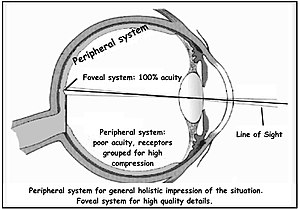Peripheral vision extends beyond your direct line of sight, covering the areas you see from the corners of your eyes. This indirect vision system helps you detect movement and navigate your environment while focusing on specific tasks.
Visual Field Boundaries
Inner Zones
The inner boundary starts at your central focus point and extends to about 60 degrees in radius. Your visual acuity drops significantly in this zone – at just 2 degrees from center, it’s already half as sharp as your central vision. By 30 degrees out, you retain only one-sixteenth of your central visual clarity.
Outer Limits
A single eye covers:
- 60 degrees upward
- 60 degrees toward your nose
- 70-75 degrees downward
- 100-110 degrees toward your temple
Both eyes together create a combined field of 130-135 degrees vertical and 200-220 degrees horizontal vision.
Functional Characteristics
Your peripheral vision excels at detecting motion and changes in light but struggles with detail and color. This comes from the distribution of two types of receptor cells:
- Rod cells: Peak at 18 degrees from center, great for low light
- Cone cells: Concentrated in the center, best for color and detail
Practical Applications
Pilots use peripheral vision to spot aircraft at night, taking advantage of rod cells’ superior low-light sensitivity. Your brain processes peripheral visual information differently than central vision, using specific areas along the interhemispheric fissure for quick reactions to side threats.
Night Vision Capabilities
In dark conditions, your peripheral vision often works better than central vision. The high concentration of rod cells at 18 degrees from center creates optimal night vision sensitivity in your near periphery, making it easier to spot faint objects by looking slightly off-center.
Citations:
https://en.wikipedia.org/wiki/Peripheral_vision
Peripheral vision, or indirect vision, is vision as it occurs outside the point of fixation, i.e. away from the center of gaze or, when viewed at large angles, in (or out of) the "corner of one's eye". The vast majority of the area in the visual field is included in the notion of peripheral vision. "Far peripheral" vision refers to the area at the edges of the visual field, "mid-peripheral" vision refers to medium eccentricities, and "near-peripheral", sometimes referred to as "para-central" vision, exists adjacent to the center of gaze.



English
Noun
peripheral vision (uncountable)
- The part of vision that occurs outside the gaze or central area of focus.

